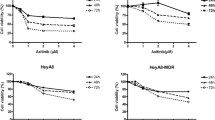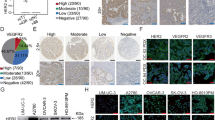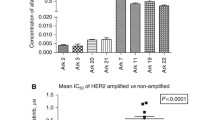Abstract
Epithelial ovarian carcinoma is the most lethal of gynecologic malignancies. There is a need to optimize the currently available treatment strategies and to urgently develop novel therapeutic agents against chemotherapy-resistant disease. The objective of our study was to evaluate neratinib’s preclinical efficacy in treating HER2-amplified ovarian cancer. Neratinib’s efficacy in treating HER2-amplified ovarian cancer was studied in vitro utilizing six primary tumor cell lines with differential HER2/neu expression. Flow cytometry was utilized to assess IC50, cell signaling changes, and cell cycle distribution. Neratinib’s in vivo efficacy was evaluated in HER2-amplified epithelial ovarian carcinoma xenografts. Three of six (50%) ovarian cancer cell lines were HER2/neu-amplified. Neratinib showed significantly higher efficacy in treating HER2/neu-amplified cell lines when compared to the non-HER2/neu-amplified tumor cell lines (mean ± SEM IC50:0.010 μM ± 0.0003 vs. 0.076 μM ± 0.005 p < 0.0001). Neratinib treatment significantly decreased the phosphorylation of the transcription factor S6, leading to arrest of the cell cycle in G0/G1 phase. Neratinib prolonged survival in mice harboring HER2-amplified epithelial ovarian carcinoma xenografts (p = 0.003). Neratinib inhibits proliferation, signaling, cell cycle progression and tumor growth of HER2-amplified epithelial ovarian carcinoma in vitro. Neratinib inhibits xenograft growth and improves overall survival in HER2/neu-amplified ovarian cancer in vivo. Clinical trials are warranted.




Similar content being viewed by others
References
Siegel RL, Miller KD, Jemal A. Cancer statistics, 2016. CA Cancer J Clin. 2016;66(1):7–30. doi:10.3322/caac.21332.
Yap TA, Carden CP, Kaye SB. Beyond chemotherapy: targeted therapies in ovarian cancer. Nat Rev Cancer. 2009;9(3):167–81. doi:10.1038/nrc2583.
Banerjee S, Kaye SB. New strategies in the treatment of ovarian cancer: current clinical perspectives and future potential. Clin Cancer Res. 2013;19(5):961–8. doi:10.1158/1078-0432.ccr-12-2243.
Stalberg K, Crona J, Razmara M, Taslica D, Skogseid B, Stalberg P. An integrative genomic analysis of formalin fixed paraffin-embedded archived serous ovarian carcinoma comparing long-term and short-term survivors. Int J Gynecol Cancer. 2016. doi:10.1097/igc.0000000000000721.
Magdalena K, Monika Z, Adam G, Magdalena R, Marzena L, Wojciech B, et al. Detection of somatic BRCA1/2 mutations in ovarian cancer—next-generation sequencing analysis of 100 cases. Cancer Med. 2016;. doi:10.1002/cam4.748.
Cohen RB. Current challenges and clinical investigations of epidermal growth factor receptor (EGFR)- and ErbB family-targeted agents in the treatment of head and neck squamous cell carcinoma (HNSCC). Cancer Treat Rev. 2014;40(4):567–77. doi:10.1016/j.ctrv.2013.10.002.
English DP, Roque DM, Santin AD. HER2 expression beyond breast cancer: therapeutic implications for gynecologic malignancies. Mol Diagn Ther. 2013;17(2):85–99. doi:10.1007/s40291-013-0024-9.
Tuefferd M, Couturier J, Penault-Llorca F, Vincent-Salomon A, Broet P, Guastalla JP, et al. HER2 status in ovarian carcinomas: a multicenter GINECO study of 320 patients. PLoS ONE. 2007;2(11):e1138. doi:10.1371/journal.pone.0001138.
Wright C, Angus B, Nicholson S, Sainsbury JR, Cairns J, Gullick WJ, et al. Expression of c-erbB-2 oncoprotein: a prognostic indicator in human breast cancer. Cancer Res. 1989;49(8):2087–90.
Berchuck A, Kamel A, Whitaker R, Kerns B, Olt G, Kinney R, et al. Overexpression of HER-2/neu is associated with poor survival in advanced epithelial ovarian cancer. Cancer Res. 1990;50(13):4087–91.
Santin AD, Bellone S, Siegel ER, Palmieri M, Thomas M, Cannon MJ, et al. Racial differences in the overexpression of epidermal growth factor type II receptor (HER2/neu): a major prognostic indicator in uterine serous papillary cancer. Am J Obstet Gynecol. 2005;192(3):813–8. doi:10.1016/j.ajog.2004.10.605.
Schwab CL, English DP, Roque DM, Bellone S, Lopez S, Cocco E, et al. Neratinib shows efficacy in the treatment of HER2/neu amplified uterine serous carcinoma in vitro and in vivo. Gynecol Oncol. 2014;135(1):142–8. doi:10.1016/j.ygyno.2014.08.006.
English DP, Bellone S, Cocco E, Bortolomai I, Pecorelli S, Lopez S, et al. Oncogenic PIK3CA gene mutations and HER2/neu gene amplifications determine the sensitivity of uterine serous carcinoma cell lines to GDC-0980, a selective inhibitor of Class I PI3 kinase and mTOR kinase (TORC1/2). Am J Obstet Gynecol. 2013;209(5):465.e1–9. doi:10.1016/j.ajog.2013.07.020.
El-Sahwi K, Bellone S, Cocco E, Cargnelutti M, Casagrande F, Bellone M, et al. In vitro activity of pertuzumab in combination with trastuzumab in uterine serous papillary adenocarcinoma. Br J Cancer. 2010;102(1):134–43. doi:10.1038/sj.bjc.6605448.
Schwab CL, English DP, Black J, Bellone S, Lopez S, Cocco E, et al. Neratinib shows efficacy in the treatment of HER2 amplified carcinosarcoma in vitro and in vivo. Gynecol Oncol. 2015;139(1):112–7. doi:10.1016/j.ygyno.2015.08.002.
Buza N, English DP, Santin AD, Hui P. Toward standard HER2 testing of endometrial serous carcinoma: 4-year experience at a large academic center and recommendations for clinical practice. Mod Pathol. 2013;26(12):1605–12. doi:10.1038/modpathol.2013.113.
English DP, Bellone S, Schwab CL, Bortolomai I, Bonazzoli E, Cocco E, et al. T-DM1, a novel antibody-drug conjugate, is highly effective against primary HER2 overexpressing uterine serous carcinoma in vitro and in vivo. Cancer Med. 2014;3(5):1256–65. doi:10.1002/cam4.274.
Rabindran SK, Discafani CM, Rosfjord EC, Baxter M, Floyd MB, Golas J, et al. Antitumor activity of HKI-272, an orally active, irreversible inhibitor of the HER-2 tyrosine kinase. Cancer Res. 2004;64(11):3958–65. doi:10.1158/0008-5472.can-03-2868.
Ocana A, Amir E, Seruga B, Martin M, Pandiella A. The evolving landscape of protein kinases in breast cancer: clinical implications. Cancer Treat Rev. 2013;39(1):68–76. doi:10.1016/j.ctrv.2012.05.004.
Engel RH, Kaklamani VG. HER2-positive breast cancer: current and future treatment strategies. Drugs. 2007;67(9):1329–41.
Bartsch R, Wenzel C, Zielinski CC, Steger GG. HER-2-positive breast cancer: hope beyond trastuzumab. BioDrugs. 2007;21(2):69–77.
Zhu Y, Guo M, Zhang L, Xu T, Wang L, Xu G. Biomarker triplet NAMPT/VEGF/HER2 as a de novo detection panel for the diagnosis and prognosis of human breast cancer. Oncol Rep. 2016;35(1):454–62. doi:10.3892/or.2015.4391.
Mar N, Vredenburgh JJ, Wasser JS. Targeting HER2 in the treatment of non-small cell lung cancer. Lung Cancer. 2015;87(3):220–5. doi:10.1016/j.lungcan.2014.12.018.
Serrano-Olvera A, Duenas-Gonzalez A, Gallardo-Rincon D, Candelaria M, De la Garza-Salazar J. Prognostic, predictive and therapeutic implications of HER2 in invasive epithelial ovarian cancer. Cancer Treat Rev. 2006;32(3):180–90. doi:10.1016/j.ctrv.2006.01.001.
Hogdall EV, Christensen L, Kjaer SK, Blaakaer J, Bock JE, Glud E, et al. Distribution of HER-2 overexpression in ovarian carcinoma tissue and its prognostic value in patients with ovarian carcinoma: from the Danish MALOVA Ovarian Cancer Study. Cancer. 2003;98(1):66–73. doi:10.1002/cncr.11476.
Slamon DJ, Clark GM, Wong SG, Levin WJ, Ullrich A, McGuire WL. Human breast cancer: correlation of relapse and survival with amplification of the HER-2/neu oncogene. Science. 1987;235(4785):177–82.
Baselga J, Arteaga CL. Critical update and emerging trends in epidermal growth factor receptor targeting in cancer. J Clin Oncol. 2005;23(11):2445–59. doi:10.1200/jco.2005.11.890.
Perez EA, Romond EH, Suman VJ, Jeong JH, Sledge G, Geyer CE Jr, et al. Trastuzumab plus adjuvant chemotherapy for human epidermal growth factor receptor 2-positive breast cancer: planned joint analysis of overall survival from NSABP B-31 and NCCTG N9831. J Clin Oncol. 2014;32(33):3744–52. doi:10.1200/jco.2014.55.5730.
Gianni L, Dafni U, Gelber RD, Azambuja E, Muehlbauer S, Goldhirsch A, et al. Treatment with trastuzumab for 1 year after adjuvant chemotherapy in patients with HER2-positive early breast cancer: a 4-year follow-up of a randomised controlled trial. Lancet Oncol. 2011;12(3):236–44. doi:10.1016/s1470-2045(11)70033-x.
Slamon D, Eiermann W, Robert N, Pienkowski T, Martin M, Press M, et al. Adjuvant trastuzumab in HER2-positive breast cancer. N Engl J Med. 2011;365(14):1273–83. doi:10.1056/NEJMoa0910383.
Chan A, Delaloge S, Holmes FA, Moy B, Iwata H, Harvey VJ, et al. Neratinib after trastuzumab-based adjuvant therapy in patients with HER2-positive breast cancer (ExteNET): a multicentre, randomised, double-blind, placebo-controlled, phase 3 trial. Lancet Oncol. 2016;17(3):367–77. doi:10.1016/s1470-2045(15)00551-3.
Goldhirsch A, Gelber RD, Piccart-Gebhart MJ, de Azambuja E, Procter M, Suter TM, et al. 2 years versus 1 year of adjuvant trastuzumab for HER2-positive breast cancer (HERA): an open-label, randomised controlled trial. Lancet. 2013;382(9897):1021–8. doi:10.1016/s0140-6736(13)61094-6.
Jelovac D, Emens LA. HER2-directed therapy for metastatic breast cancer. Oncology. 2013;27(3):166–75.
Lheureux S, Krieger S, Weber B, Pautier P, Fabbro M, Selle F, et al. Expected benefits of topotecan combined with lapatinib in recurrent ovarian cancer according to biological profile: a phase 2 trial. Int J Gynecol Cancer. 2012;22(9):1483–8. doi:10.1097/IGC.0b013e31826d1438.
Teplinsky E, Muggia F. Targeting HER2 in ovarian and uterine cancers: challenges and future directions. Gynecol Oncol. 2014;135(2):364–70. doi:10.1016/j.ygyno.2014.09.003.
Chow LW, Xu B, Gupta S, Freyman A, Zhao Y, Abbas R, et al. Combination neratinib (HKI-272) and paclitaxel therapy in patients with HER2-positive metastatic breast cancer. Br J Cancer. 2013;108(10):1985–93. doi:10.1038/bjc.2013.178.
Wong KK, Fracasso PM, Bukowski RM, Lynch TJ, Munster PN, Shapiro GI, et al. A phase I study with neratinib (HKI-272), an irreversible pan ErbB receptor tyrosine kinase inhibitor, in patients with solid tumors. Clin Cancer Res. 2009;15(7):2552–8. doi:10.1158/1078-0432.ccr-08-1978.
Burstein HJ, Sun Y, Dirix LY, Jiang Z, Paridaens R, Tan AR, et al. Neratinib, an irreversible ErbB receptor tyrosine kinase inhibitor, in patients with advanced ErbB2-positive breast cancer. J Clin Oncol. 2010;28(8):1301–7. doi:10.1200/jco.2009.25.8707.
Nahta R, Esteva FJ. HER2 therapy: molecular mechanisms of trastuzumab resistance. Breast Cancer Res. 2006;8(6):215. doi:10.1186/bcr1612.
Martin M, Bonneterre J, Geyer CE Jr, Ito Y, Ro J, Lang I, et al. A phase two randomised trial of neratinib monotherapy versus lapatinib plus capecitabine combination therapy in patients with HER2+ advanced breast cancer. Eur J Cancer. 2013;49(18):3763–72. doi:10.1016/j.ejca.2013.07.142.
Carlson R. I-SPY 2 trial: neoadjuvant neratinib improves pathologic complete response in HR-/HER2+ breast cancer. Oncology Times. 2014;36(10):25–6.
Park JW, Liu MC, Yee D, Yau C, van ‘t Veer LJ, Symmans WF, et al. Adaptive randomization of neratinib in early breast cancer. N Engl J Med. 2016;375(1):11–22. doi:10.1056/NEJMoa1513750.
Canonici A, Gijsen M, Mullooly M, Bennett R, Bouguern N, Pedersen K, et al. Neratinib overcomes trastuzumab resistance in HER2 amplified breast cancer. Oncotarget. 2013;4(10):1592–605. doi:10.18632/oncotarget.1148.
Awada A, Dirix L, Manso Sanchez L, Xu B, Luu T, Dieras V, et al. Safety and efficacy of neratinib (HKI-272) plus vinorelbine in the treatment of patients with ErbB2-positive metastatic breast cancer pretreated with anti-HER2 therapy. Ann Oncol. 2013;24(1):109–16. doi:10.1093/annonc/mds284.
Funding
This work was supported in part by R01 CA154460-01 and U01 CA176067-01A1 grants from NIH, and grants from the Deborah Bunn Alley Foundation, the Tina Brozman Foundation, the Discovery to Cure Foundation and the Guido Berlucchi Foundation to A.D. Santin. This investigation was also supported by NIH Research Grant CA-16359 from the NCI to A.D. Santin.
Author information
Authors and Affiliations
Corresponding author
Ethics declarations
Conflict of interest
The authors report no conflicts of interest.
Ethical approval
All applicable international, national, and/or institutional guidelines for the care and use of mice were followed. Ethical approval for involving mice in our study was obtained from Yale Institutional Animal Care and Use Committee (IACUC) which granted the ethical approval after review. The policies set forth by the IACUC at Yale University were followed while housing and treating the mice.
Human and animal rights
This article does not contain any studies with human participants performed by any of the authors.
Rights and permissions
About this article
Cite this article
Menderes, G., Bonazzoli, E., Bellone, S. et al. Efficacy of neratinib in the treatment of HER2/neu-amplified epithelial ovarian carcinoma in vitro and in vivo. Med Oncol 34, 91 (2017). https://doi.org/10.1007/s12032-017-0956-8
Received:
Accepted:
Published:
DOI: https://doi.org/10.1007/s12032-017-0956-8




